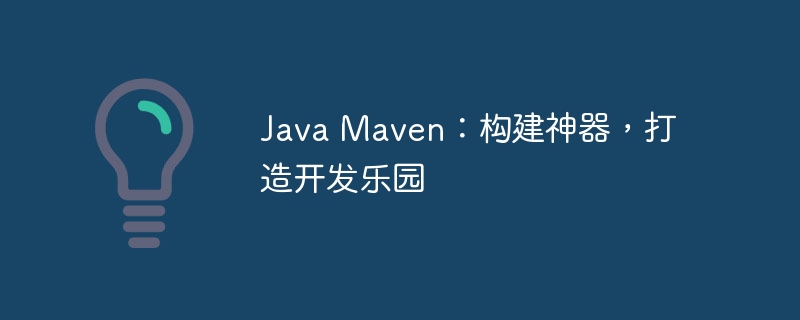Java Maven: Build artifacts and create a development paradise

Java Maven, as an essential tool for modern Java project management, plays an important role in project construction and dependency management. PHP editor Xiaoxin will take you to deeply explore the magic of Maven and learn how to use it to create a development paradise and improve the efficiency and stability of the project. Through this article, you will master the basic concepts and usage skills of Maven, making your Java development journey smoother!
Maven is a build system based on projects, using XML files (pom.xml) to define project dependencies, build configurations and plugins. Maven simplifies the distribution and deployment process by packaging your project into a self-contained unit called a jar file.
Dependency Management
One of the core functions of Maven is to manage project dependencies. It automatically obtains and installs the necessary libraries and frameworks by connecting to the central repository (Maven Central) and third-party repositories. This avoids the hassle of manually downloading and adding dependencies and ensures that your project always uses the latest version of the library.
Automated build process
Maven enables automation of the build process by providing a set of predefined build lifecycle stages. These stages include compilation, testing, packaging and deployment. Developers can adjust and extend the build process to meet specific needs by customizing the pom.xml file.
Plug-in system
Maven's flexible and extensible plug-in system allows developers to customize the build process. Plug-ins provide a wide range of functionality, from generating documentation to performing custom tasks. Developers can easily enhance Maven's default functionality by installing and configuring plug-ins.
Collaboration and Reusability
Maven promotes team collaboration because it uses standard project structures and build conventions. This allows team members to easily share and understand the project and reduces the risk of build failure. In addition, Maven encourages the reusability of code and configuration, allowing developers to create modular, reusable project components.
Code Example
The following pom.xml fragment shows an example of Maven dependency management:
<dependencies> <dependency> <groupId>junit</groupId> <artifactId>junit</artifactId> <version>4.13.2</version> <scope>test</scope> </dependency> <dependency> <groupId>org.mockito</groupId> <artifactId>mockito-core</artifactId> <version>4.6.1</version> <scope>test</scope> </dependency> </dependencies>
In this example, we declare two dependencies: JUnit (for unit testing) and Mockito (for mocking). These dependencies will be automatically downloaded and added to the project during the build process.
Advantages of Maven
The advantages of using Maven include:
- Simplified dependency management
- Automated build process
- Flexible scalability
- Promote collaboration
- Improve maintainability and reusability
in conclusion
Java Maven is a powerful build tool that provides rich functionality for Java developers. By automating the build process, simplifying dependency management, and promoting team collaboration, Maven creates an efficient development paradise for developers. Embracing Maven can significantly improve productivity and project success.
The above is the detailed content of Java Maven: Build artifacts and create a development paradise. For more information, please follow other related articles on the PHP Chinese website!

Hot AI Tools

Undresser.AI Undress
AI-powered app for creating realistic nude photos

AI Clothes Remover
Online AI tool for removing clothes from photos.

Undress AI Tool
Undress images for free

Clothoff.io
AI clothes remover

AI Hentai Generator
Generate AI Hentai for free.

Hot Article

Hot Tools

Notepad++7.3.1
Easy-to-use and free code editor

SublimeText3 Chinese version
Chinese version, very easy to use

Zend Studio 13.0.1
Powerful PHP integrated development environment

Dreamweaver CS6
Visual web development tools

SublimeText3 Mac version
God-level code editing software (SublimeText3)

Hot Topics
 1378
1378
 52
52
 How does Java's classloading mechanism work, including different classloaders and their delegation models?
Mar 17, 2025 pm 05:35 PM
How does Java's classloading mechanism work, including different classloaders and their delegation models?
Mar 17, 2025 pm 05:35 PM
Java's classloading involves loading, linking, and initializing classes using a hierarchical system with Bootstrap, Extension, and Application classloaders. The parent delegation model ensures core classes are loaded first, affecting custom class loa
 How do I implement multi-level caching in Java applications using libraries like Caffeine or Guava Cache?
Mar 17, 2025 pm 05:44 PM
How do I implement multi-level caching in Java applications using libraries like Caffeine or Guava Cache?
Mar 17, 2025 pm 05:44 PM
The article discusses implementing multi-level caching in Java using Caffeine and Guava Cache to enhance application performance. It covers setup, integration, and performance benefits, along with configuration and eviction policy management best pra
 How can I use JPA (Java Persistence API) for object-relational mapping with advanced features like caching and lazy loading?
Mar 17, 2025 pm 05:43 PM
How can I use JPA (Java Persistence API) for object-relational mapping with advanced features like caching and lazy loading?
Mar 17, 2025 pm 05:43 PM
The article discusses using JPA for object-relational mapping with advanced features like caching and lazy loading. It covers setup, entity mapping, and best practices for optimizing performance while highlighting potential pitfalls.[159 characters]
 How do I use Maven or Gradle for advanced Java project management, build automation, and dependency resolution?
Mar 17, 2025 pm 05:46 PM
How do I use Maven or Gradle for advanced Java project management, build automation, and dependency resolution?
Mar 17, 2025 pm 05:46 PM
The article discusses using Maven and Gradle for Java project management, build automation, and dependency resolution, comparing their approaches and optimization strategies.
 How do I create and use custom Java libraries (JAR files) with proper versioning and dependency management?
Mar 17, 2025 pm 05:45 PM
How do I create and use custom Java libraries (JAR files) with proper versioning and dependency management?
Mar 17, 2025 pm 05:45 PM
The article discusses creating and using custom Java libraries (JAR files) with proper versioning and dependency management, using tools like Maven and Gradle.




